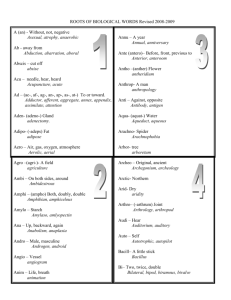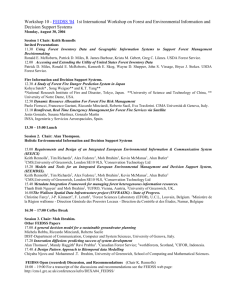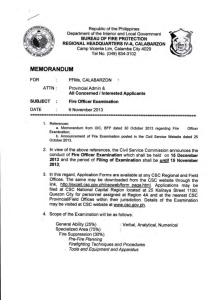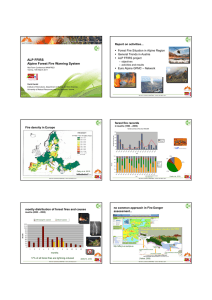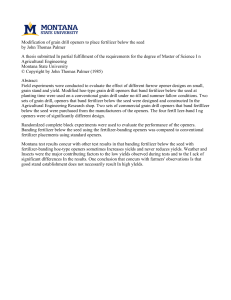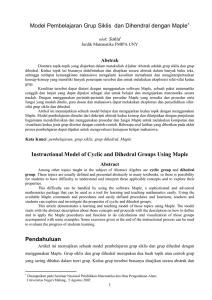Looking beyond climate: Disturban g y
advertisement
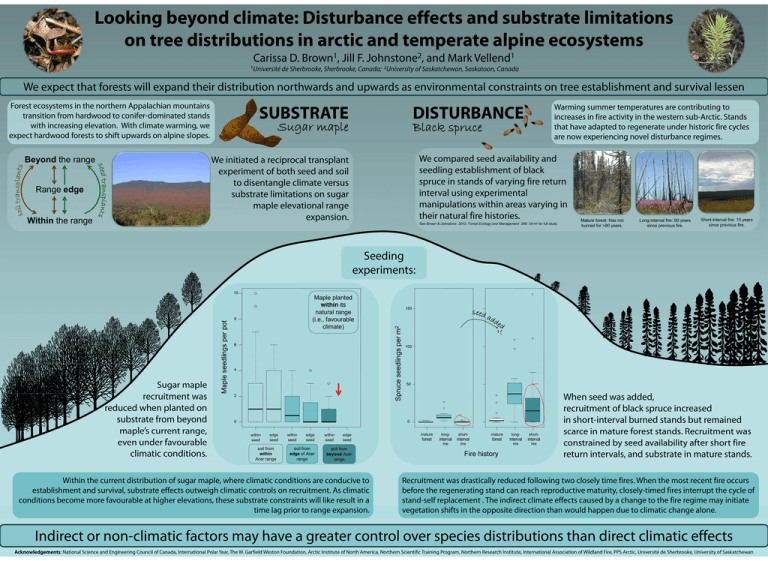
L ki g b li Di b nce effects ff d substrate b li i i y d climate: Disturban limitations beyond and Looking t ib ti iin arctic ti an d temperate t p t alpine lpi ecosystems y t on ttree di distributions nd D Carissa D. 1 Brown , F Jillll F. 2 hnstone , Joh d and 1 ll d Markk Vellend 1Université de Sherbrooke Sherbrooke, Sherbrooke Sherbrooke, Canada; 2Universityy of Saskatchewan Saskatchewan, Saskatoon Saskatoon, Canada W expect t will ill expand i di t ib ti northwards th d and d upwa d as environmental i t l constraints t i t on tree t t bli h t and d survival i l llessen We p t th p d th p rds thatt fforests their distribution establishment Forest ecosystems y in the northern Appalachian mountains conifer-dominated transition hardwood t iti from f h d d to t conifer if dominated d i t d stands t d with increasing g elevation. elevation With climate warming, warming g, we d d fforests to shift hif upwards d on alpine l i slopes l expect h slopes. hardwood SUBSTRATE DISTURBANCE g maple p Sugar p e Black spruce Bla k sp W compared d availability il bili y and d We p d seed dli g establishment bli h bl k seedling off black iin stands d off varying fire return spruce p yi g fi i l using i g experimental l interval p i p l y g in h areas varying within manipulations h i naturall fi i fire hi histories their histories. Wee initiated t ated a reciprocal ec p oca transplant t a sp a t experiment e pe e t of o both bot seed and a d soil so to disentangle climate versus substrate limitations on sugar maple elevational range expansion expansion. Beyond the range y g g edge g Range Within t the e range a ge Warming g summer temperatures p are contributing g to sub-Arctic increases in fire f activity in the h western sub b Arctic. Stands d that adapted historic th t have h d t d to t regenerate t under d hi t i fire fi cycles l are now experiencing p g novel disturbance regimes. regimes g See Brown & Johnstone Johnstone. 2012 2012. Forest Ecology and Management 266: 34 34-41 study. 41 for full study Mature forest: Has not burned for >80 yyears. Long-interval Long interval fire: 90 years since p previous fire. Short-interval Short interval fire: 15 years since previous i i fifire. S d Seed ding di g experim ments: M l planted l d Maple within ithi its it atu al range a ge natural ((i.e., (i , ffavourable bl climate)) 8 6 4 2 0 1 0 150 Sp Spru uce e se see ed dlin gs p pe err m 2 Sugar S g maple pl i recruitment was d d when h planted d on reduced pl b ffrom b substrate beyond y d maple pl ’s current range, g maple’s range d favourable f bl even under li i conditions di i climatic conditions. M Ma ap ple e sse ee ed dliin ng gss pe perr po pott 10 100 50 0 within d seed edge seed soil from within Acer range A within seed edge seed soil from edge of Acer range within seed edge seed soil from beyond Acer range g Within the current distribution of sugar g maple, maple p where climatic conditions are conducive to establishment t bli h t and d survival, survival i l substrate b t t effects ff t outweigh t i h climatic li ti controls t l on recruitment recruitment. it t As A climatic li ti conditions become more favourable at higher g elevations elevations,, these substrate constraints will like result in a time lag l prior to range expansion expansion. mature forest long longinterval fire fi short shortinterval fire fi mature forest Fire history long longinterval fire fi short shortinterval fire fi h seed d was added, dd d, When added bl k spruce d recruitment off black increased p h lb d stands d b d in short-interval burned but remained d Recruitment was scarce in mature fforest stands. stands f short ffire constrained byy seed availabilityy after intervals, and substrate in mature stands. stands return intervals, Recruitment was drasticallyy reduced following g two closelyy time fires. fires When the most recent fire occurs b f before the th regenerating ti stand t d can reach h reproductive d ti maturity maturity, t it closely closely-timed l l timed ti d fires fi interrupt i t t the th cycle l off stand self replacement stand-self p . The indirect climate effects caused byy a change g to the fire regime g mayy initiate vegetation shifts h f in the h opposite direction d than h would ld happen h due d to climatic l change h alone alone. l Indirect d ect o or non-climatic non o cclimatic at c factors acto s may maay have haa e a greater g eate cont co trol o o over e er species spec es distrib distributions d st buttions o s than t a direct d ect climatic c at c e effects ects Acknowledgements: National Science and Engineering Council of Canada Canada, International Polar Year Year, The W W. Garfield Weston Foundation Foundation, Arctic Institute of North America, America No orthern Scientific Training Program, Program Northern Research Institute Institute, International Association of Wildland Fire, Fire PPS Arctic Arctic, Université de Sherbrooke, Sherbrooke University of Saskatchewan
